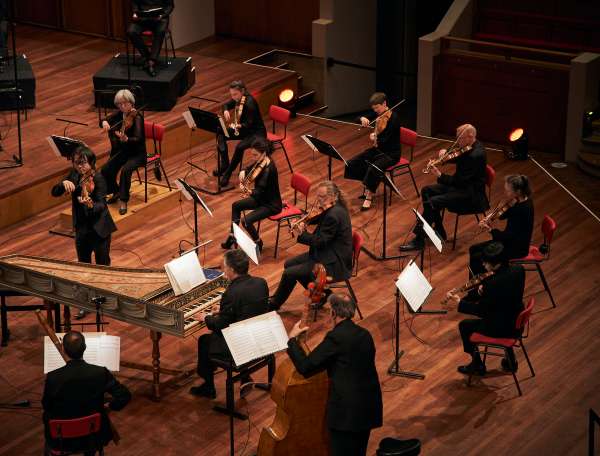

The Well-Tempered Clavier II No. 2 in C minor
BWV 871 performed by Christine Schornsheim
at the Anatomiegebouw in Utrecht
Behind the music
Textbook example with impact
Bach’s quick fingers lend expressivity even to pure counterpoint
Restlessly, the two parts in the Prelude pass the musical material back and forth to one another, alternating quick runs with an accompaniment full of leaps. The form is reminiscent of the first Invention, BWV 772, for example. The Fugue, too, is educational in character as a model of ‘partimento’; a sort of schematic method for providing interesting decoration to a musical motif.
So what are two analytical works, almost finger exercises, doing in the second part of the Wohltemperirte Clavier? The answer is simple. What we see purely as an artistic highlight was regarded by Bach of equal importance as an exercise book for his students – a sample sheet of ideas and styles. It is nice to be performing this work in the Anatomiegebouw, which is traditionally a centre for research and education. So this two-part work in C minor fulfils a very specific function that was essential in the greater whole, and the choice seems to have been made at the start of compiling the collection.
The four-part Fugue misleads the listener. The exposition already appears to be over after three theme entrances, and a considerable passage of ‘free playing’ follows, which is not too spectacular apart from a few fiercely clashing dissonances. The second half then begins not only with an inverted theme (further on in the tenor), but also with a version at half tempo in the alto, in answer to the soprano. It is only then, two-thirds of the way through the piece and amid all sorts of semi-themes, that the bass enters; first with that slow theme in augmentatio, followed almost immediately afterwards by the inversion. With barely a chance to prove itself, the bass then lands on a pedal point and concludes with a wonderful arpeggio finale. Here, the structure and the expressive power of harmony count for more than extravagant counterpoint.
WTC II
We recorded Bach’s first book of Preludes and Fugues in all the keys at the homes of 24 different musicians. For this second part, performed in its entirety by Christine Schornsheim, we chose 12 very different locations in Utrecht, to celebrate the 900th anniversary of our home city.
Das Wohltemperirte Clavier, BWV 846-893
Composing 48 keyboard pieces in all 24 keys was the sort of challenge Bach enjoyed. In each of the two parts of the Wohltemperirte Clavier, he brought together the musical couple prelude and fugue 24 times; twelve in minor keys and twelve in major. In the preludes, he gave free rein to his imagination, and demonstrated mathematical tours de force in the fugues. In contrast to the iron discipline Bach had to apply to his church compositions, here he could abandon himself to intellectual Spielerei without worrying about deadlines.
The first part of the Wohltemperirte Clavier dates from 1722, although it contains some music that was written in the preceding five years. There is less clarity about the history of part two. Bach compiled this second manuscript only around 1740, although once again some of the preludes and fugues it contains date from a much earlier period. Bach described the target group for this collection of pieces as follows: ‘Zum Nutzen und Gebrauch der Lehr-begierigen Musicalischen Jugend, als auch dere in diesem studio schon habil seyenden besonderem ZeitVertreib’ (For both the education of the industrious musical youngster and the enjoyment of those well-versed in this material’).
- BWV
- 871
- Title
- Prelude and fugue in C minor
- Epithet
- no. 2 from the Well-Tempered Clavier II
- Instrument
- harpsichord
- Genre
- harpsichord works
- Serie
- Das Wohltemperirte Clavier II
- Year
- ca. 1740
- City
- Leipzig
Extra videos
Vocal texts
Original
Translation
Credits
-
- Release date
- 8 September 2022
-
- Recording date
- 20 April 2022
-
- Location
- Anatomiegebouw, Utrecht
-
- Harpsichordist
- Christine Schornsheim
-
- Harpsichord
- Bruce Kennedy, 1989 after Michael Mietke
-
- Director, camera and lights
- Gijs Besseling
-
- Music recording
- Guido Tichelman, Pim van der Lee
-
- Music edit and mix
- Guido Tichelman
-
- Camera, lights
- Danny Noordanus
-
- Data handling
- Stefan Ebels
-
- Assistant music recording
- Marloes Biermans
-
- Producer
- Josine Olgers
Discover
Help us to complete All of Bach
There are still many recordings to be made before the whole of Bach’s oeuvre is online. And we can’t complete the task without the financial support of our patrons. Please help us to complete the musical heritage of Bach, by supporting us with a donation!

